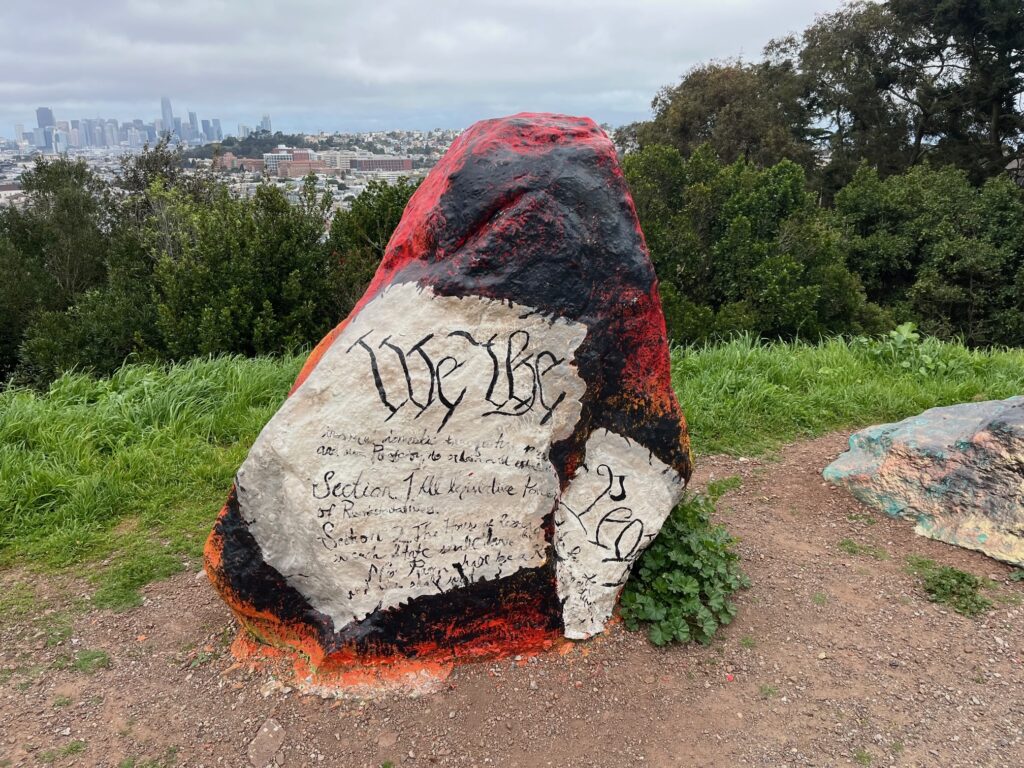You can often get the mood of progressive San Francisco from a rock on Bernal Hill. It’s right where Folsom St. meets Bernal Heights Blvd., and it’s not a terribly large rock; you can’t see if from any distance, and it’s hardly a tourist attraction. But it’s sort of an un-curated community art project; every few weeks, someone comes along and paints something on it. Sometimes, it’s just a nice colorful image, and sometimes it’s a political statement. After a while, someone else comes along and paints something different. None of the installations, as it were, last more than a month.
It’s a rare and cool thing in the city: Nobody seems to fight over it. There’s rarely anything offensive, and it wouldn’t last, anyway. I’ve never seen anyone actually painting the rock, and since I walk my dog past it every day, the work must happen at night.
Here’s what it looked like on March 1:

The brutal, difficult budget year, one of the worst in decades, officially kicks off Wednesday/5 when the Budget and Appropriations Committee hears a report from the city controller on the status of municipal finances.
The news, of course, is bad—although there are bright spots. The property transfer tax, which progressives fought to raise on high-end sales, is bringing in $229 million, $10.8 million more than projected. Much of that money is supposed to go to affordable housing, although former Mayor London Breed, angry that Sup. Dean Preston was the sponsor, refused to spend it the way the voters intended.
Overall, the city is going to finish the year $367 million to the good, mostly because of cuts that have taken place under Breen and Mayor Daniel Lurie, and that’s $35 million more than expected.
But that’s not grounds to celebrate. From the controller:
[The improvement] Reduces projected shortfall in the upcoming two-year budget from $875.9 million to $840.2 million.
Still a big, nasty number.
Lurie has instituted a hiring freeze (for everyone except public safety) and has asked all departments (except the cops, who get more money) to plan for as much as a 15 percent cut.
That’s big money; the Department of Public Health budget, which includes SF General and Laguna Honda Hospital, is $3.2 billion, and 15 percent of that is $480 million. This, while the city is facing enormous public health issues. The budget for Muni is $1.4 billion; can you cut $210 million without profoundly impacting service? No.
The Controller’s Office figures assume there are no increases in revenue; that’s the controller’s job. The figures also assume no cuts in federal funding. But balancing this budget, facing likely federal cuts, is going to be a disaster, a bloodbath, with essential services vanishing (just as federal services and state services are vanishing) unless new revenue is on the table.
So far, in the Lurie budget, it’s not.
That hearing starts at 1:30pm.
The full board will vote on a resolution supporting the SFMTA’s plans to fund Muni by letting private developers build market-rate housing on public land. Affordable housing advocates say public land should be used for the benefit of the public; Sup. Myrna Melgar, the sponsor of the bill, says that Muni is desperate for cash and should use the land it controls as a way to raise revenue.
The measure has five co-sponsors, and passed out of the Land Use and Transportation Committee 3-0.
The Planning Commission will also hold a hearing on Muni’s development plans Thursday/6.
The reality is that the supes can’t stop what SFMTA wants to do; it’s an independent agency. The planners can have a lot of input, though—and this has the potential to pretty dramatically change a lot of neighborhoods.

Muni has identified 25 sites that could be developed. As a planning memo notes:
SFMTA has identified 25 sites for inclusion in the current Joint Development Portfolio. Seventeen of the 25 sites are located within areas presently being considered for rezoning through the Housing Element implementation’s Expanding Housing Choices program and seven are in and around Downtown. The one site that not in either of these areas is the Potrero Yard site in the Mission district that the Planning Commission approved in 2024. The Potrero Yard modernization project entails the demolition of the existing bus facility, and the construction of a new state-of-the-art facility along with 465 affordable and workforce dwelling units. … These sites include one major transit facility (Presidio Yard at Masonic and Geary), one bus terminal loop, one parking garage, and 14 surface parking lots (see attached list and map). Planning staff is working with SFMTA staff to ensure potential development of the sites is accommodated by the rezoning appropriate for each location.
That’s a lot of property, in a lot of places that the city wants to upzone (with all of the impacts related to that.)
Muni’s goals for development look like this:
1. Maximize Public Good. Generate substantial long-term revenues to improve our transportation system.
2. Create Inclusive and Well-Connected Communities. Create development projects that foster inclusive communities and improve access to opportunity and resources.
3. Build Sustainable and Resilient Projects. Build development projects that improve working conditions for SFMTA staff, use green and resilient practices and reduce Vehicle Miles Traveled and greenhouse gas emissions.
What this doesn’t say: Affordable housing as a priority. It also, oddly, doesn’t talk about the fact that building a lot of new housing and commercial projects in West Side neighborhoods will require a lot of new Muni service in areas that are now pretty badly served by transit—and that will cost a lot of money.
We’re also talking very long term here: None of this will happen in time to address the current budget crisis, and by the time development starts to happen, it’s possible that this city, state, and nation has come to its senses and started to tax the rich to pay for public services.
Or not—in which case we are in much, much deeper trouble than this development plan can begin to address.




